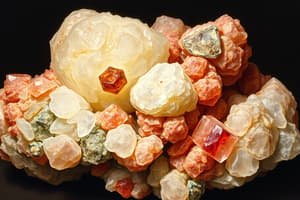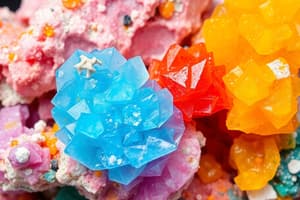Podcast
Questions and Answers
Why is sugar NOT a mineral?
Why is sugar NOT a mineral?
Sugar is not a mineral because sugar is plant-based and minerals are inorganic.
Why are minerals silicates?
Why are minerals silicates?
Silicon and oxygen are the most abundant elements in Earth's surface.
Why are ilmenite and rutile considered to be ores?
Why are ilmenite and rutile considered to be ores?
Ilmenite and rutile are considered ores because they both contain titanium which can be refined from them profitably.
List four characteristics all minerals share.
List four characteristics all minerals share.
Is diamond a mineral, gem, ore or none?
Is diamond a mineral, gem, ore or none?
Is magma a mineral, gem, ore or none?
Is magma a mineral, gem, ore or none?
Is halite a mineral, gem, ore or none?
Is halite a mineral, gem, ore or none?
Is malachite a mineral, gem, ore or none?
Is malachite a mineral, gem, ore or none?
Is quartz a mineral, gem, ore or none?
Is quartz a mineral, gem, ore or none?
Is pyrite a mineral, gem, ore or none?
Is pyrite a mineral, gem, ore or none?
Is hematite a mineral, gem, ore or none?
Is hematite a mineral, gem, ore or none?
What three qualities of titanium make it a good material for producing hip or knee replacements?
What three qualities of titanium make it a good material for producing hip or knee replacements?
How would a collector of minerals determine the hardness of an unknown mineral specimen?
How would a collector of minerals determine the hardness of an unknown mineral specimen?
Is coal a mineral? Explain.
Is coal a mineral? Explain.
Flashcards
Why isn't sugar a mineral?
Why isn't sugar a mineral?
Sugar is not a mineral because it is plant-based (organic), while minerals are inorganic.
Why are many minerals silicates?
Why are many minerals silicates?
Silicon and oxygen are the most abundant elements in Earth's surface.
Why are ilmenite and rutile ores?
Why are ilmenite and rutile ores?
They contain titanium, which can be extracted profitably.
Mineral characteristics
Mineral characteristics
Signup and view all the flashcards
Diamond: mineral, gem, or ore?
Diamond: mineral, gem, or ore?
Signup and view all the flashcards
Magma: mineral, gem, or ore?
Magma: mineral, gem, or ore?
Signup and view all the flashcards
Halite: mineral, gem, or ore?
Halite: mineral, gem, or ore?
Signup and view all the flashcards
Malachite: mineral, gem, or ore?
Malachite: mineral, gem, or ore?
Signup and view all the flashcards
Quartz: mineral, gem, or ore?
Quartz: mineral, gem, or ore?
Signup and view all the flashcards
Pyrite: mineral, gem, or ore?
Pyrite: mineral, gem, or ore?
Signup and view all the flashcards
Hematite: mineral, gem, or ore?
Hematite: mineral, gem, or ore?
Signup and view all the flashcards
Titanium qualities for replacements
Titanium qualities for replacements
Signup and view all the flashcards
Determine mineral hardness?
Determine mineral hardness?
Signup and view all the flashcards
Is coal a mineral?
Is coal a mineral?
Signup and view all the flashcards
Study Notes
Definition of Minerals
- Sugar is not classified as a mineral due to its plant-based origin; minerals are inorganic substances.
- Minerals possess four key characteristics: naturally occurring, inorganic, unique chemical composition, and crystalline solid structure.
Silicates and Elements
- Silicates are abundant because silicon and oxygen are the most prevalent elements found in Earth’s crust.
Ores and Titanium
- Ilmenite and rutile are known as ores because they contain titanium, which can be economically extracted and refined.
Classifications of Materials
- Diamond is categorized as both a mineral and a gem.
- Magma is not classified as a mineral, gem, or ore.
- Halite is identified as a mineral.
- Malachite qualifies as a mineral, gem, and ore.
- Quartz is recognized as a mineral.
- Pyrite is classified as a mineral.
- Hematite is recognized as both a mineral and an ore.
Properties of Titanium
- Titanium is favored for hip or knee replacements due to its key properties: nontoxicity, lightweight nature, and durability.
Determining Mineral Hardness
- A collector assesses the hardness of an unknown mineral by employing the Mohs scale of hardness and conducting scratch tests with known minerals for comparison.
Coal and Mineral Classification
- Coal does not qualify as a mineral, as it is derived from decayed organic matter, while minerals consist of inorganic materials.
Studying That Suits You
Use AI to generate personalized quizzes and flashcards to suit your learning preferences.



